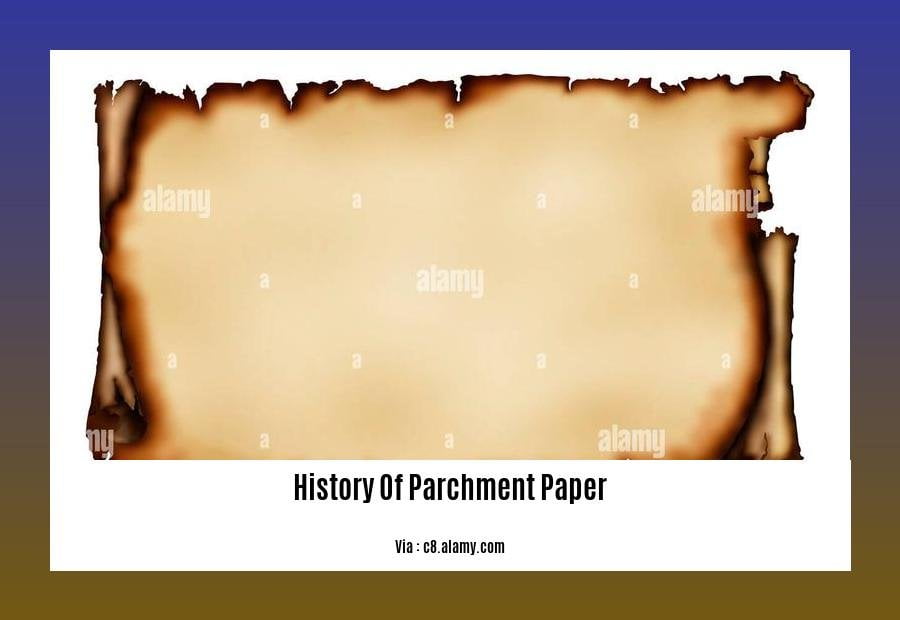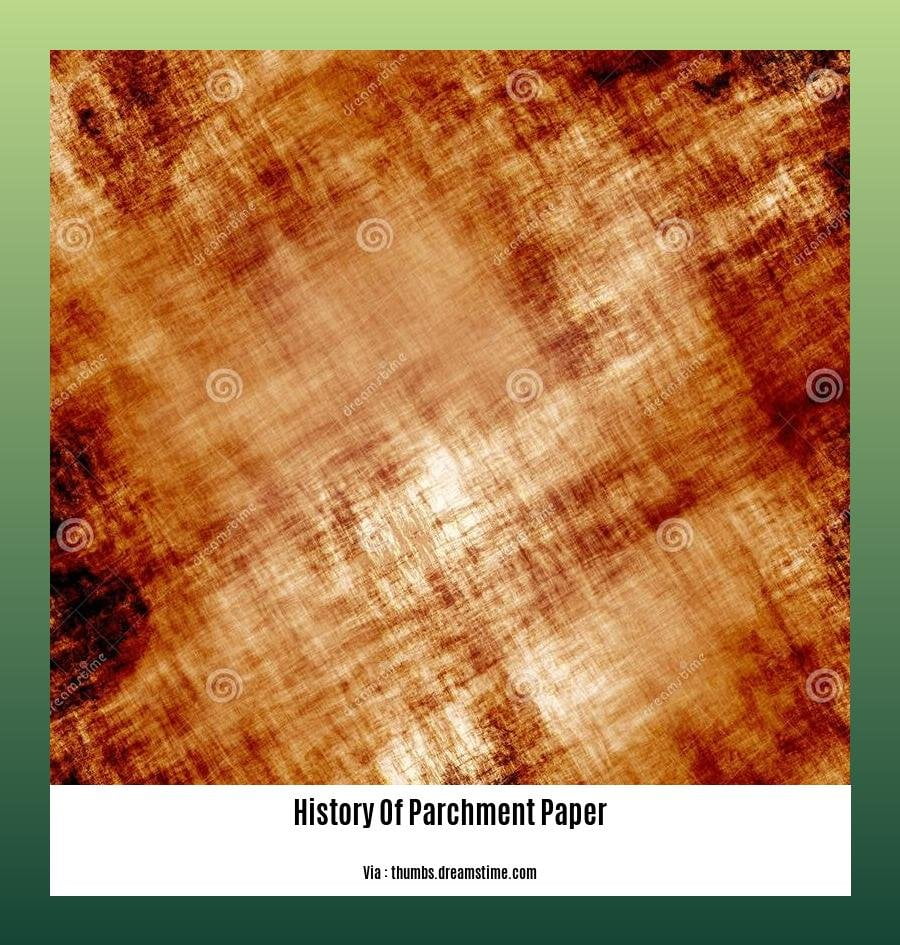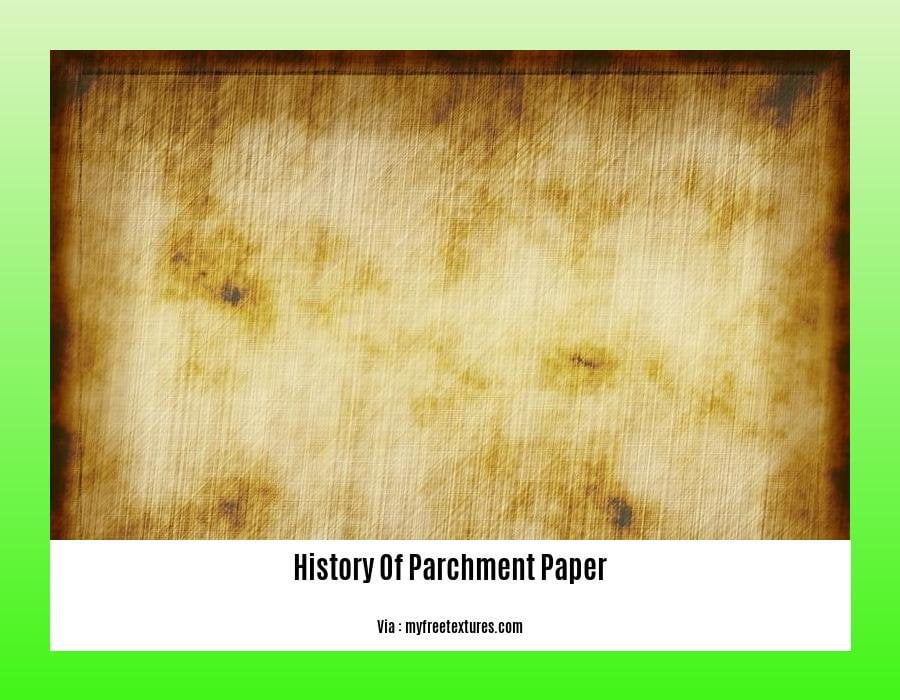Embark on a journey through time as we delve into [The History of Parchment Paper: A Journey Through the Legacy of Ancient Writing Materials]. From its humble beginnings in ancient civilizations to its pivotal role in shaping the course of knowledge, parchment paper has left an indelible mark on the annals of history. In this article, we’ll uncover the secrets embedded in parchment’s composition, exploring its craftsmanship and the stories it holds. Join us as we shed light on the enduring legacy of this remarkable medium.
Key Takeaways:
Parchment got its name from the ancient city of Pergamum in Asia Minor.
It was invented around the 2nd century BCE.
The King of Pergamum (197-159 B.C.) is credited with its invention.
Parchment was widely used in Europe for many centuries.
The United Kingdom even used it to record new laws up until the 21st century.
History of Parchment Paper

Embarking on a voyage through the annals of parchment paper unveils a compelling narrative of human ingenuity, cultural exchange, and the enduring power of the written word. This remarkable material, crafted from animal hides, played a pivotal role in shaping the course of civilization, serving as the medium for countless literary, historical, and scientific masterpieces.
The Genesis of Parchment Paper
In the bustling metropolis of Pergamum, nestled within the heart of Asia Minor, the history of parchment paper finds its origins. During the second century BCE, as the demand for writing materials surged amidst the flourishing intellectual climate, a fortuitous innovation emerged. Attributed to the ingenious King Eumenes II, parchment was conceived as a durable and versatile alternative to the increasingly scarce papyrus.
The Art of Parchment Making
The transformation of animal hides into parchment entailed a meticulous and time-consuming process. Artisans meticulously selected hides, primarily from sheep, goats, or calves, ensuring their suitability for the delicate task. After a thorough cleaning and soaking process, the hides were stretched onto frames and meticulously scraped to remove any imperfections.
The Rise of Parchment Paper
Parchment’s exceptional durability and resistance to wear and tear propelled its widespread adoption throughout Europe. Its resilience proved ideal for preserving the wisdom of ancient texts, religious scriptures, and official documents.
The Enduring Legacy of Parchment Paper
Despite the advent of paper, parchment endured as a preferred medium for centuries. Its exceptional qualities, coupled with its association with prestige and authenticity, ensured its continued use for significant documents, such as royal charters, legal contracts, and religious manuscripts.
The United Kingdom’s Enduring Embrace of Parchment
In a testament to parchment’s enduring legacy, the United Kingdom remained steadfast in its utilization of this venerable material. Until the early 21st century, parchment remained the medium of choice for recording new laws and regulations, underscoring its enduring significance in the annals of legal history.
The Cultural and Historical Significance of Parchment Paper
Beyond its practical applications, parchment played a pivotal role in shaping cultural and historical narratives. The preservation and dissemination of knowledge across vast distances and generations were made possible by its enduring nature. Parchment manuscripts served as conduits for transmitting literature, philosophy, scientific discoveries, and religious teachings, fostering intellectual exchange and cultural cross-pollination.
Conclusion
The history of parchment paper is an intricate tapestry woven with innovation, craftsmanship, and the enduring pursuit of preserving and disseminating knowledge. From its humble origins in ancient Pergamum to its widespread adoption and enduring legacy, parchment stands as a testament to human ingenuity and the power of the written word. Its influence can still be felt today, as we continue to marvel at the remarkable stories and wisdom etched upon its timeless surface.
Dive deep into the evolution of paper bags, discovering their fascinating journey from simple containers to stylish accessories. history of paper bags
Unlock the secrets behind the art of pedicures, tracing their captivating history from ancient rituals to modern-day pampering practices. history of pedicures
Embark on a rhythmic adventure through the ages, exploring the captivating history of percussion instruments and their mesmerizing impact on music. history of percussion instruments
The Role of Parchment in Preserving Ancient Knowledge
Parchment, a durable animal skin writing material, played a remarkable role in safeguarding the wisdom of ancient civilizations. For centuries, scribes meticulously crafted parchment from the skins of sheep, goats, and calves, treating them with precision to create smooth surfaces ideal for writing.
Parchment's remarkable durability and resistance to wear and tear made it the perfect medium for preserving knowledge in a time when papyrus, its predecessor, was vulnerable to decay. Unlike papyrus, which was crafted from the delicate fibers of the papyrus plant, parchment could withstand the passage of time, ensuring the survival of written works for generations to come.
The adoption of parchment marked a significant turning point in the preservation of ancient knowledge. As parchment became widely adopted throughout Europe, it facilitated the creation of important documents such as royal charters, legal contracts, and religious manuscripts. Its durability ensured that these records could be preserved and referenced in the years to come.
One of the most significant roles of parchment was in the preservation and transmission of religious texts. In the early centuries of Christianity, parchment was used to create codices, or bound books, which allowed for the compilation and organization of religious teachings. These codices were instrumental in spreading the Christian faith and preserving its sacred texts for future generations.
Parchment also played a crucial role in the preservation of classical literature and philosophy. Ancient Greek and Roman texts were meticulously copied onto parchment, ensuring their survival and transmission to future generations. This allowed scholars and thinkers to access and study the works of great minds such as Plato, Aristotle, and Homer, shaping the intellectual landscape of the Western world.
**Key Takeaways:**
* Parchment's durability and resistance to wear and tear made it the perfect medium for preserving knowledge in ancient civilizations.
* Parchment facilitated the creation of important documents such as royal charters, legal contracts, and religious manuscripts, ensuring their survival for generations.
* Parchment was instrumental in the preservation and transmission of religious texts, particularly in the early centuries of Christianity.
* Parchment played a crucial role in the preservation of classical literature and philosophy, allowing scholars to access and study the works of great minds.
Citations:
* [Parchment: Preservation and Conservation | SpringerLink](
* [Parchment | Britannica](
Famous Parchment Documents and Manuscripts

Behold, as we embark on an enthralling adventure through history, where we’ll uncover the secrets hidden within famous parchment documents and manuscripts. These remarkable writings, inscribed on the enduring canvas of parchment, have left an indelible mark on our collective knowledge and cultural heritage. Join me as we venture into this world of ancient wisdom and explore the captivating tales etched onto these timeworn treasures.
Key Takeaways:
The Codex Sinaiticus: This venerable manuscript, dating back to the 4th century AD, ranks among the world’s oldest extant Bibles, containing both the Old and New Testaments. Its profound significance lies in its remarkably preserved text, providing invaluable insights into the earliest forms of the Christian scriptures.
The Magna Carta: Proclaimed in 1215, this momentous parchment document stands as a cornerstone of constitutional law, enshrining the principle that even the sovereign is subject to the law. The Magna Carta’s enduring legacy has shaped the development of legal systems worldwide, ensuring the protection of individual rights and liberties.
The Gutenberg Bible: This revolutionary text, printed on parchment in the mid-15th century, marked a pivotal moment in the history of printing and book production. Johannes Gutenberg’s groundbreaking invention of the printing press, coupled with parchment’s durability and aesthetic appeal, paved the way for the mass dissemination of knowledge and fueled the Renaissance.
The Dead Sea Scrolls: Unearthed in the mid-20th century, these ancient manuscripts, preserved in desert caves near the Dead Sea, offer a glimpse into Jewish life and thought during the Second Temple period. They contain biblical texts, commentaries, and sectarian writings, shedding light on the religious and cultural landscape of the ancient Near East.
The Book of Kells: This exquisitely illuminated manuscript, crafted by Irish monks around 800 AD, showcases the pinnacle of Celtic art and calligraphy. Its vibrant colors, intricate designs, and elaborate ornamentation have earned it a reputation as one of the most splendidly decorated manuscripts in the world.
These iconic parchment documents and manuscripts are but a few examples of the vast wealth of knowledge and history preserved on this remarkable writing material. They stand as testaments to the ingenuity, artistry, and thirst for knowledge that have shaped human civilization.
Conclusion:
As we conclude our journey through the realm of famous parchment documents and manuscripts, we are left with a profound appreciation for the enduring legacy of this ancient writing material. Parchment has played a pivotal role in the dissemination of knowledge, the development of law and governance, the preservation of religious texts, and the flourishing of art and literature. Its strength, longevity, and aesthetic appeal have ensured that these precious documents have survived the passage of time, allowing us to connect with the past and marvel at the wisdom and creativity of our ancestors.
The Enduring Legacy and Impact of Parchment Paper
Imagine yourself transported back in time to a world without paper. Instead, people relied on materials like papyrus and parchment to record their thoughts and ideas. Among these ancient writing materials, parchment stands out for its durability, versatility, and cultural significance. Join us as we delve into the enduring legacy and impact of parchment paper and explore its fascinating journey through history.
Key Takeaways:
Parchment, crafted from animal hides, emerged as an alternative to papyrus in the 2nd century BC.
Its durability and resistance to wear and tear made it ideal for preserving important documents and texts.
Parchment played a pivotal role in the development of bookmaking, facilitating the spread of knowledge and ideas throughout the ancient world.
The use of parchment continued well into the Middle Ages, becoming the preferred material for manuscripts, legal documents, and religious texts.
Even with the advent of paper, parchment retained its significance for specific purposes, such as diplomas, certificates, and special editions of books.
Today, parchment is still valued for its historical and cultural significance, often used in restoration projects and as a canvas for artwork and calligraphy.
From Ancient Origins to Enduring Legacy
The story of parchment begins in the ancient city of Pergamum, located in present-day Turkey. Around the 2nd century BC, when the supply of papyrus from Egypt became scarce, the scholars of Pergamum sought an alternative writing material. Their ingenuity led to the development of parchment, crafted from specially treated animal hides, primarily sheep, goats, and calves.
The Superiority of Parchment
Compared to papyrus, parchment offered several advantages. Its durability made it resistant to wear and tear, allowing documents to withstand the test of time. It was also less prone to tearing and damage from insects, making it an ideal choice for preserving important texts. Furthermore, parchment provided a smoother and more even writing surface, enhancing the legibility and aesthetics of manuscripts.
A Catalyst for Knowledge Dissemination
The widespread adoption of parchment revolutionized the world of bookmaking. Its durability and suitability for writing on both sides facilitated the production of books that were more compact, portable, and could withstand frequent handling. This, in turn, led to the proliferation of knowledge and ideas throughout the ancient world.
A Legacy of Cultural Significance
Parchment’s impact extended beyond its practical uses. It became a symbol of authority and prestige, used for official documents, legal contracts, and religious texts. The use of parchment added a sense of solemnity and importance to these documents, reinforcing their legal and historical significance.
Preserving the Past for the Future
Even with the advent of paper in the 1st century AD, parchment retained its significance for specific purposes. Its durability made it the preferred choice for diplomas, certificates, and special editions of books. Today, parchment continues to be valued for its historical and cultural significance. It is used in restoration projects to preserve ancient manuscripts and as a canvas for artwork and calligraphy, keeping the legacy of this remarkable writing material alive.
Citations:
Parchment: A Brief History – Dartmouth Ancient Books Lab
FAQ
Q1: What is the origin of parchment?
A1: Parchment was developed in the ancient city of Pergamum, Asia Minor, during the 2nd century BCE. It was invented as an alternative to papyrus, which was becoming scarce at the time.
Q2: How was parchment made?
A2: Parchment is made from animal skins, usually from sheep, goats, or calves. The skins are first soaked in a lime solution, then stretched and scraped to remove the hair and flesh. The resulting material is then dried and bleached, producing a smooth and durable writing surface.
Q3: Why was parchment used for writing?
A3: Parchment was valued for its durability and longevity compared to other writing materials, such as papyrus. It is resistant to moisture and insects, making it ideal for preserving important documents and texts.
Q4: How did parchment impact the dissemination of knowledge?
A4: The use of parchment played a significant role in the dissemination of knowledge throughout history. It enabled the creation and preservation of books, scrolls, and other written documents, which facilitated the sharing of information and ideas across cultures and generations.
Q5: Is parchment still used today?
A5: Parchment is still used today for certain purposes, such as in the production of high-quality books, diplomas, and legal documents. However, it is no longer widely used as a primary writing material, having been replaced by paper.
- Crypto Quotes’ Red Flags: Avoid Costly Mistakes - June 30, 2025
- Unlock Inspirational Crypto Quotes: Future Predictions - June 30, 2025
- Famous Bitcoin Quotes: A Deep Dive into Crypto’s History - June 30, 2025
















